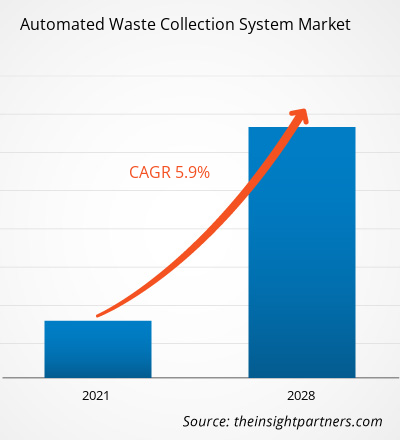자동 폐기물 수거 시스템 시장은 2020년 2억 3,488만 달러 규모였으며, 2028년에는 3억 6,537만 달러에 이를 것으로 예상됩니다. 2021년부터 2028년까지 연평균 성장률(CAGR) 5.9%로 성장할 것으로 예상됩니다.
자동 폐기물 수거 시스템 시장을 견인하는 핵심 요인은 폐기물의 적절한 처리를 위한 정부의 정책입니다. 전 세계 정부 기관들은 폐기물 수거 및 분리에 대한 규칙과 규정을 시행해 왔습니다. 예를 들어, 인도 정부는 폐기물 발생원에서의 분리를 강조하는 새로운 고형 폐기물 관리 규정을 제정했습니다. 새로운 규정은 폐기물을 발생원에서 분리하여 회수, 재사용 및 재활용을 통해 자본으로 전환하도록 요구합니다. 따라서 폐기물 발생자는 폐기물을 수거업체에 넘기기 전에 생분해성 폐기물, 건조 폐기물(플라스틱, 종이, 금속, 목재 등), 그리고 가정 유해 폐기물(기저귀, 냅킨, 모기 기피제, 세척제 등)의 세 가지 분류 과정을 거쳐야 합니다. 그러나 대규모 폐기물 분리는 매우 번거로운 과정이기 때문에 정부 당국은 폐기물 분리를 위한 자동화 솔루션에 집중하고 있습니다. 이러한 요인들이 전 세계 여러 국가에서 자동 폐기물 수거 시스템 도입에 영향을 미치고 있습니다.
이 보고서의 일부, 국가 수준 분석, Excel 데이터 팩을 포함하여 모든 보고서에 대한 사용자 정의를 무료로 받을 수 있을 뿐만 아니라 스타트업 및 대학을 위한 훌륭한 제안 및 할인을 이용할 수 있습니다
자동 폐기물 수거 시스템 시장: 전략적 통찰력

- 이 보고서의 주요 주요 시장 동향을 확인하세요.이 무료 샘플에는 시장 동향부터 추정 및 예측에 이르기까지 데이터 분석이 포함됩니다.
전 세계 자동 폐기물 수거 시스템 제조업체들은 지역 및 지방 정부가 지자체와 민간 기관의 스마트하고 지능적인 폐기물 또는 쓰레기 수거 및 분류 솔루션 투자를 장려함에 따라 제한적인 영향을 받았습니다. 가정 폐기물량이 크게 증가함에 따라 주택 부문의 자동 폐기물 수거 시스템 수요가 급증했습니다. 그러나 인간의 이동 제한으로 인한 공급망 차질로 인해 미국, 캐나다, 영국, 이탈리아, 중국 등 선진국과 개발도상국 모두에서 AWCS의 구축 및 설치가 지연되었습니다. 이는 전 세계 자동 폐기물 수거 시스템 시장의 매출 성장이 평소보다 더딘 추세를 보인 데 따른 것입니다.
시장 분석 - 자동 폐기물 수거 시스템 시장, 자동 폐기물 수거 시스템 통합 투자 증가
자동 폐기물 수거 시스템은 의료 기관 전반에서 높은 선호도를 보이고 있습니다. 폐기물 관리 및 수거 시스템은 밀폐된 전용 파이프 네트워크를 통해 환자 병동의 적재 스테이션에서 중앙 수거 작업장까지 시속 60마일(약 96km)의 속도로 폐기물을 이송합니다. 폐기물, 퇴비, 오염된 린넨을 적절한 수거함으로 옮기는 데 별도의 경로가 사용됩니다. 이는 접객업, 의료, 소매업과 같은 산업에서 자동 수거 기술에 대한 투자 증가로 이어지고 있습니다. 예를 들어, Logiwaste AB는 스톡홀름의 카롤린스카 병원에 세 가지 자동 폐기물 수거 시스템을 공급했습니다. 이 시스템은 잔여 폐기물, 종이, 플라스틱, 종이 포장재 등 네 가지 유형의 폐기물을 처리할 것으로 예상됩니다. Logiwaste AB는 또한 트론헤임의 Tiller Åuml;st, 칼스타드 중앙 병원, 트론헤임의 Grilstad Marina, 베이징의 China Life와 AWCS 공급 계약을 체결했습니다. 마찬가지로 Atreo는 Parkland 병원, Humber River 병원, Brigham and Women's 병원, 텍사스 대학교 사우스웨스턴 메디컬 센터 등에 AWCS를 공급하는 프로젝트를 수주했습니다. 따라서 다양한 산업, 특히 의료 분야의 기업들이 자동 폐기물 수거 및 관리 시스템 구축에 투자하는 규모가 증가함에 따라 향후 몇 년간 시장 성장이 가속화될 것으로 예상됩니다.
제품 유형 기반 인사이트
자동 폐기물 수거 시스템 시장은 제품 유형에 따라 고정형과 이동형으로 구분됩니다. 고정형 부문은 2020년에 더 큰 시장 점유율을 기록했습니다.
콘텐츠 품질 기반 인사이트
자동 폐기물 수거 시스템 시장은 최종 사용자 기준으로 공항, 교육 기관, 병원, 기업 사무실, 호텔/레스토랑 등으로 구분됩니다. 공항 부문은 예측 기간 동안 가장 높은 연평균 성장률(CAGR)을 기록할 것으로 예상됩니다.
자동 폐기물 수거 시스템 시장 참여 기업들은 주로 첨단 고효율 제품 개발에 집중하고 있습니다.
- 2021년, Caverion은 생명공학 기업 Thermo Fisher Scientific Baltics의 신축 건물 턴키 프로젝트를 수행했습니다. 이 프로젝트는 리투아니아 빌니우스에서 진행되었습니다.
- 2021년, 스타방에르 대학병원은 Logiwaste AB의 자동 폐기물 및 세탁물 수거 시스템을 선택했습니다. 이 시스템은 투입구부터 터미널까지 폐기물과 세탁물을 처리하는 사용자 친화적이고 효율적이며 위생적인 방법을 제공합니다.
자동 폐기물 수거 시스템 시장
The Insight Partners의 분석가들은 예측 기간 동안 자동 폐기물 수거 시스템 시장에 영향을 미치는 지역별 동향과 요인을 면밀히 분석했습니다. 이 섹션에서는 북미, 유럽, 아시아 태평양, 중동 및 아프리카, 그리고 중남미 지역의 자동 폐기물 수거 시스템 시장 부문 및 지역별 현황도 살펴봅니다.
자동 폐기물 수거 시스템 시장 보고서 범위
| 보고서 속성 | 세부 |
|---|---|
| 시장 규모 2020 | US$ 234.88 Million |
| 시장규모별 2028 | US$ 365.37 Million |
| 글로벌 CAGR (2020 - 2028) | 5.9% |
| 이전 데이터 | 2018-2019 |
| 예측 기간 | 2021-2028 |
| 다루는 세그먼트 |
By 제품 유형
|
| 포함된 지역 및 국가 | 북미
|
| 시장 선도 기업 및 주요 회사 프로필 |
|
자동 폐기물 수거 시스템 시장 참여자 밀도: 비즈니스 역학에 미치는 영향 이해
자동 폐기물 수거 시스템 시장은 소비자 선호도 변화, 기술 발전, 그리고 제품 이점에 대한 인식 제고 등의 요인으로 인한 최종 사용자 수요 증가에 힘입어 빠르게 성장하고 있습니다. 수요가 증가함에 따라 기업들은 제품 및 서비스 확장, 소비자 니즈 충족을 위한 혁신, 그리고 새로운 트렌드를 적극 활용하고 있으며, 이는 시장 성장을 더욱 가속화하고 있습니다.

- 을 얻으세요 자동 폐기물 수거 시스템 시장 주요 주요 플레이어 개요
- 고정형
- 모바일형
자동 폐기물 수거 시스템 시장 - 최종 사용자별
- 공항
- 교육 기관
- 병원
- 기업 사무실
- 호텔/레스토랑
- 기타
자동 폐기물 수거 시스템 시장 - 지역별
북미
- 미국
- 캐나다
- 멕시코
유럽
- 독일
- 프랑스
- 이탈리아
- 영국
- 러시아
- 나머지 유럽
아시아 태평양(APAC)
- 호주
- 중국
- 인도
- 일본
- 대한민국
- 나머지 APAC
중동 및 아프리카(MEA)
- 사우디 아라비아
- UAE
- 나머지 MEA
남미 (SAM)
- 브라질
- 기타 SAM
회사 프로필
- Aerbin ApS
- AMCS 그룹
- Caverion Corporation
- Envac AB
- Logiwaste AB
- MariMatic Oy
- MEIKO
- Evac 그룹
- MABAT
- STREAM 환경
- 과거 분석(2년), 기준 연도, CAGR을 포함한 예측(7년)
- PEST 및 SWOT 분석
- 시장 규모 가치/거래량 - 글로벌, 지역, 국가
- 산업 및 경쟁 환경
- Excel 데이터세트
최근 보고서
사용 후기
구매 이유
- 정보에 기반한 의사 결정
- 시장 역학 이해
- 경쟁 분석
- 고객 인사이트
- 시장 예측
- 위험 완화
- 전략 기획
- 투자 타당성 분석
- 신흥 시장 파악
- 마케팅 전략 강화
- 운영 효율성 향상
- 규제 동향에 발맞춰 대응






















 무료 샘플 받기 - 자동 폐기물 수거 시스템 시장
무료 샘플 받기 - 자동 폐기물 수거 시스템 시장